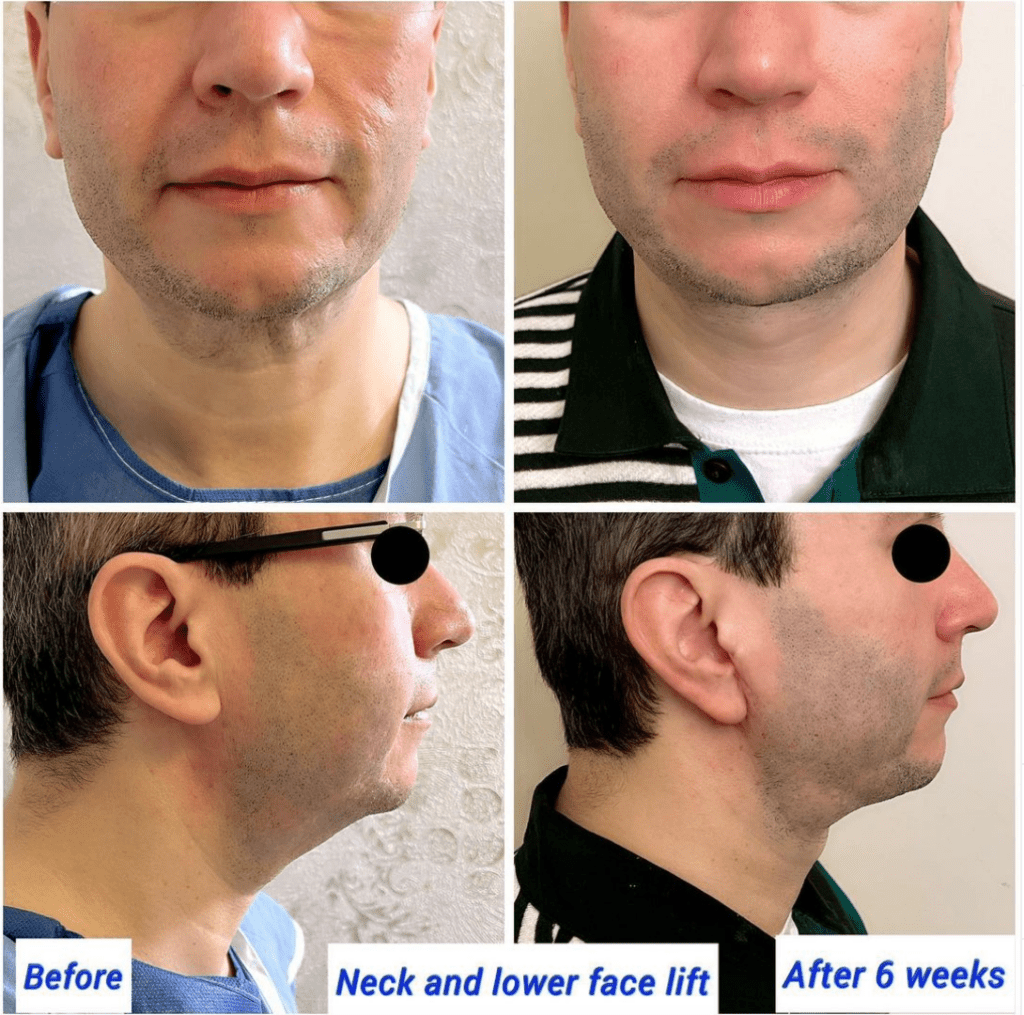With any type of cosmetic surgery, it’s normal to have questions. During your facelift recovery, you will need to take it slow. That means avoiding certain daily activities until you’re at a specific point in your recovery. A facelift will temporarily impact how you sleep, move, and look after your hair and body. Keep reading to find out more about washing hair after facelift surgery and how to do it safely during your facelift recovery.
Why Should You Consider A Facelift?
As we age, we go through certain physical changes. Our skin loses elasticity, and we also lose fat tissue and muscle. It results in wrinkles, loose skin around the neck and other signs of ageing. While these changes are natural, some people often feel self-conscious about how they look.
Facelift surgery focuses on the bottom two-thirds of the face and neck region. The surgeon removes excess skin, wrinkles and folds and tightens the facial muscles. You can have a facelift as a standalone procedure or combine it with other procedures like a brow lift or eyelid surgery.
You are a great candidate for a facelift if:
- You have loose skin on your face and neck
- You want to reverse the signs of ageing and look younger
- You have lost weight and have excess skin on the face and neck as a result
- You have deep lines and wrinkles in the corners of your mouth
- You have visible jowls (excess saggy and droopy skin below the chin and jawline region)

What Happens During A Facelift?
A facelift helps lift and tighten the skin below the eyes. For any lift above the eyes, you might want to consider getting a brow lift. During facelift surgery, the surgeon lifts and repositions the skin and soft tissue on the lower face.
The surgery takes about two hours, and you get to go home the same day. During the procedure, the plastic surgeon tightens the underlying muscles, lifts the skin and repositions it. Sutures are placed at the hairline to hold the skin in place and keep scarring to a minimum. Depending on the results you are going for, there are different types of facelift surgery you might consider:
Traditional Facelift
During a traditional facelift, the surgeon makes an incision along the hairline that ends behind the ears. As a result, scarring is more pronounced on your hairline and the natural facial creases. It’s the reason why you need to be extra careful about washing hair after facelift surgery.
The surgeon separates the skin from the underlying tissues, tightens the muscles and repositions excess fat. The skin is then lifted, and excess skin is removed. The surgeon will then wrap the surgical site with bandages. If there is excessive fluid, drains may also be placed in the surgical site.
Minimal-Access Cranial Suspension (MACS)
The MACS facelift is a minimally invasive face and neck lift. The main difference from a traditional facelift is that the incisions made are much smaller. The surgeon will tighten and reposition the excess skin through these incisions.
Keyhole Surgery
The surgeon makes small incisions on the face and inserts a telescopic camera. The camera shows the surgeon the muscle that need tightening and where fat needs to be removed. Most people who opt for keyhole surgery do so because it’s less invasive, recovery time is shorter and there is less scarring.
Neck Lift
A neck lift tightens and lifts excess skin on the neck. During the procedure, the surgeon removes excess fat and skin underneath your chin. They will also remove any deep lines and wrinkles by tightening the muscles through small incisions. Sometimes liposuction can help remove excess fat.
You can do a facelift and neck lift as individual procedures. However, most people opt for the whole rejuvenation package by having both procedures done at the same time. Combining the two procedures not only saves you money but recovery time.
For those considering a non-surgical alternative and looking for the best Harley Street fillers instead? Non-invasive procedures like Botulinum Toxin and dermal fillers also work to eliminate ageing signs.
What to Expect During Your Facelift Recovery
After your surgery, you will wake up with a large dressing on your face. When you go home, this dressing will be removed, and you will have a chin strap with cotton underneath. Your surgeon will show you how to wear this. In general, you will need to wear the chin strap for about 2 weeks.
It’s important to know that thinning of the hair can be a side effect of a facelift. There may be transient thinning in the areas adjacent to the sutures. If this happens, it’s because of a temporary shock to the hair follicle. It usually resolves within a few months.
During your facelift recovery time, there will be certain restrictions in place, such as:
- No bending over or stooping (bending over increases pressure in the face, which can worsen swelling and lead to bleeding).
- No lifting more than 15 lbs in the first 2 weeks
- No wearing glasses
- No smoking
- No shaving for the first week
- Avoid the sun altogether while you have bruising
- Sleep with your head elevated for the first two weeks after your surgery
Washing Hair After Facelift Surgery: Here’s What to Do
When it comes to washing hair after facelift surgery, remember to be patient. Although it can be tempting to dive straight into the shower, you need to give your body time to start healing before you wash your hair. After 48 hours, you can take the chin strap off to wash your hair. In the first week, only use baby shampoo and only apply conditioner to the ends of the hair so that you avoid the incision site. Use lukewarm water when you wash your hair.
Usually, you can have your hair washed at the salon 1 week after your surgery. But avoid using high heat on the hair and be careful not to rest your incisions on the rim of the washbowl. Avoid using the hot setting on a hairdryer for several weeks. You should delay colouring your hair for at least six weeks.
Whether you’re washing your body, hair or face, keep in mind that you need to be gentle. Try not to disrupt the areas of the sutures. Washing hair after facelift surgery can be just what you need to feel like your normal self when you’re feeling tired after cosmetic surgery. While it’s perfectly fine to wash your hair after your procedure, you must be gentle and use only lukewarm water.

It can take several attempts when washing hair after facelift surgery to remove the ointments and oils from your hair after the surgery. While the stitches are in place, avoid using hairspray, gels, and conditioner around the incision site. Also, avoid wearing hairpieces for at least 3 weeks because they could snag the suture site.
In general, after about 6 weeks, you will be getting back to normal, your energy levels return, and the main recovery period is over. In reality, once you’re through the 2-week mark, the bulk of the recovery is over. But, there are still things you won’t be able to do over the next several weeks. Make sure to stick to your post-operative appointment schedule so that your surgeon can guide you through your recovery.
Are you looking for a cosmetic surgeon in London? Learn more about the Harley Clinic and facelift surgery on our cosmetic surgery blog. You can also schedule an appointment by contacting our London clinic on Harley Street.













